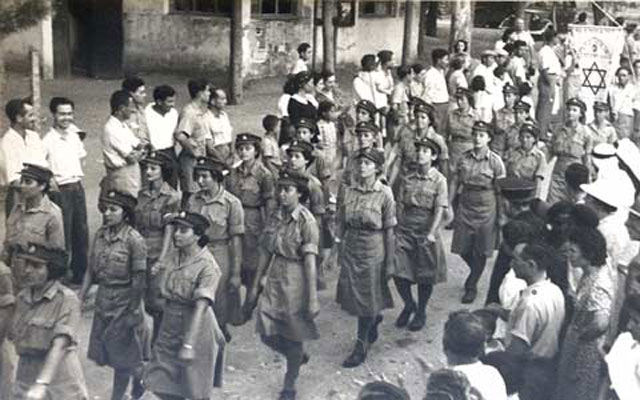Sunday 22 March 1942
 |
| An ATS (Auxiliary Territorial Service) recruiting parade in Rishon le-Zion (Rishon LeTsiyon) on March 22, 1942 (Esther Herlitz, Jewish Women's Archive). |
 |
| Japanese General Yamashita, leader in the Philippines, on the cover of the 22 March 1942 Time magazine. |
The temperature rises above freezing on the front north of Moscow, where the German Operation Brueckenschlag enters its second day toward the pocket at Demyansk. The Germans make good progress against spotty Soviet resistance. The first objective, the Redyat River, is coming within sight, but the snow is turning to slush, which favors the defense. The Soviets are determined to take the pocket before it is relieved and are sending in reinforcements from both the north and south. They also are preparing two paratrooper brigades to land in the Demyansk pocket and take it from within.
European Air Operations: It is a quiet day on the Channel front, with no major operations.
 |
| "Navy Asks For More Men For Production" is a headline in the 22 March 1942 Greenville (South Carolina) News. |
U-373 (Oblt. Paul-Karl Loeser), on its fourth patrol out of La Pallice, torpedoes and sinks 5575-ton British freighter Thursobank about 200 miles southeast of Nantucket. There are 30 dead and 34 survivors. This incident has a peculiar case of mutiny after the sinking when Chinese crewmen, who outnumber the British survivors, refuse to share their food with the British. The Chinese crewmen are arrested when rescued after three days by passing tanker Havsten.
Seas are rough along the North Atlantic convoy routes. One ship, 5786-ton Norwegian tanker Nueva Andalucia, runs aground off Mars Rock, Halifax Harbor. It is ultimately is towed to port but not repaired until 1947. All 39 men aboard survive.
 |
| Bomb damage in Malta on or about 22 March 1942. |
Propaganda/Partisans: The BBC begins sending news in Morse Code to resistance fighters on the Continent.
British/Indian Relations: Sir Stafford Cripps is in India (the "Cripps Mission") attempting to arrange a settlement with Indian nationalists. Cripps is friends with Jawaharlal Nehru, but he has an unclear mandate from the British government. The British viceroy, Lord Linlithgow, is hostile to the Cripps Mission, and with good reason - one of Cripps' proposals is to remove Linlithgow. Cripps is only able to promise what the Indian Nationalists want - Dominion Status and ultimately full independence - after the war. Ultimately, the Cripps Mission fails. Mahatma Gandhi comments sarcastically that Cripps' promise of Dominion Status after the war was a "post-dated cheque drawn on a failing bank."
 |
| Dr. Frank Thone poses an interesting question about solar power in the 22 March 1942 Galveston (Texas) Daily News. |
March 1942
March 1, 1942: Second Battle of Java Sea
March 2, 1942: Huge Allied Shipping Losses at Java
March 3, 1942: Japan Raids Western Australia
March 4, 1942: Second Raid On Hawaii
March 5, 1942: Japan Takes Batavia
March 6, 1942: Churchill Assaults Free Speech
March 7, 1942: British Defeat in Burma
March 8, 1942: Rangoon Falls to Japan
March 9, 1942: Japanese Conquest of Dutch East Indies
March 10, 1942:US Navy attacks Japanese Landings at Lae
March 11, 1942: Warren Buffett's First Stock Trade
March 12, 1942: Japan Takes Java
March 13, 1942: Soviets Attack In Crimea Again
March 14, 1942: The US Leans Toward Europe
March 15, 1942: Operation Raubtier Begins
March 16, 1942: General MacArthur Gets His Ride
March 17, 1942: MacArthur Arrives in Australia
March 18, 1942: Japan Attacks In Burma
March 19, 1942: Soviets Encircled on the Volkhov
March 20, 1942: "I Shall Return," Says MacArthur
March 21, 1942: Germans Attack Toward Demyansk
March 22, 1942: Second Battle of Sirte
March 23, 1942: Hitler's Insecurity Builds
March 24, 1942: Bataan Bombarded
March 25, 1942: Chinese Under Pressure in Burma
March 26, 1942: Win Or Die, Vows MacArthur
March 27, 1942: The Battle of Suusari
March 28, 1942: The St. Nazaire Commando Raid
March 29, 1942: The Free Republic of Nias
March 30, 1942: Japanese-Americans Off Bainbridge Island
March 31, 1942: Japanese Seize Christmas Island
2020

No comments:
Post a Comment